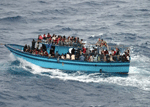‘Lampedusa’ forces EU asylum policy overhaul
Published on Mon, 2013-10-07 23:00
The Italian government has published the names of the occupants of the boat that drowned near Lampedusa on October 3. All those on the list appear to be Eritreans. At the weekend hundreds of bodies were recovered, washed ashore on the Italian island of Lampedusa. The European Union is soul-searching and identifying the problems of its increasingly repressive refugee and asylum policy. A meeting of Ministers of Home Affairs has been called in Luxemburg to consider a package of measures, in a first response to the Lampedusa tragedy. Observers are pointing out that the effect of the European policy to effectively control the ‘safe routes’, forces the most desperate refugees to take ever bigger risks in their attempt to reach safety. It is in this context the particular circumstances of the refugees who are trapped matter and should be acknowledged. Eritrea produces an unusually high number of refugees. At the moment there are about 5,000 refugees each month, according to CIA estimates; UNHCR registers around 3,000 refugees each month. These refugees defy a shoot-to-kill policy at the border. In light of these figures, Europe carries out a contradictory policy. On the one hand Europe prevents the refugees from Eritrea to enter the EU, even though all EU member states recognise the dictatorial nature of the Eritrean regime. On the other hand it cooperates with Eritrea, because this country has a geostrategic location on the Red Sea and is an important transit for international shipping. The EU still has an embassy in Asmara, even if the embassy officials are hardly allowed to move in the country. Only a small amount of the vast number of Eritrean refugees arrive in North Africa, the majority is received in African countries. For those who arrive in North Africa, the situation is a lot more difficult. In the Sinai, refugees are threatened by organised human traffickers who ask high ransoms for their release. This is associated with cruel torture and many do not survive or are killed. In Egypt, Yemen and Libya the refugees are locked up in detention centres where they are malnourished and do not have access to asylum procedures. In Israel the refugees were also detained, but the Supreme Court repealed the law stating that the measures under the law were ‘disproportionate’. Israel has however constructed a double fence on its Southern border, preventing Africans from entering the country. For the vast majority of those who nevertheless do reach Israel, asylum is not an option. All European member states recognise that the majority of Eritrean refugees are indeed entitled to asylum. But the detention centres in Southern Europe, where the majority of refugees arrive, are overflowing and once in Greece, Italy or Malta they have great difficulty in accessing asylum procedures. The necessary institutional structures to receive them are lacking. Since the economic crisis, which has hit these countries hard, the situation of the refugees has seriously deteriorated. The implementation of the EU Dublin Convention, which states that asylum must be asked in the country of entry, creates further problems for the refugees. Referring to this Agreement the EU Member States refuse to take responsibility and push the refugees back to Southern Member States. Hence the refugee and asylum policy needs to be better coordinated from Brussels. A successful outcome of the European Home Affairs Ministers on October 7-8 will depend on whether the European Union acknowledges that the majority of Eritrean refugees are likely to be entitled to asylum. The European Commission must identify a coherent policy to ensure that the refugees get access to an asylum procedure. European Member States must also act in solidarity to provide an answer to the challenge of the large flow of refugees by offering internal redistribution of refugees from Southern to other European Member States. Besides, the European Commission must be given a greater role in managing this. The measures that are needed have been set out in an Open Letter to Ministers and the EU Commission. A more robust approach to the Eritrean regime is also necessary and the EU should invoke the means it has to make clear that it does not accept the human rights violations taking place in the country. The European Union can instigate procedures it has under its Cotonou Partnership Agreement to do this. Meanwhile the Eritrean national channel, EriTV, does not acknowledge that the victims in Lampedusa are Eritreans. But the Eritrean Youth Solidarity for Change has started a campaign to send the recovered bodies back home. This symbolises the hope that Eritrean refugees share, that one day they will walk again on the soil of the country where they belong. Prof. Dr. Mirjam van Reisen, professor International Social Responsibility at the Tilburg University, is author of 'Human Trafficking in the Sinai: Refugees between life and death', Wolf Legal Publishers, 2012. She is founding director of the Europe External Policy Advisors (EEPA) in Brussels and member of the International Commission on Eritrean Refugees (ICER). » |




